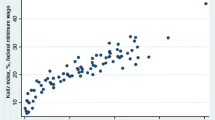Abstract
Federal minimum wage statutes cover only 70 percent of the work force and 30 percent of all employers. State laws are designed to close some of these coverage gaps and in some cases to set higher wage floors. Hence, differences in state wage floors and coverage should affect employment rates and wage distributions, particularly among low-skilled workers. Evidence from the National Longitudinal Ssurveys of Youth is mixed, however: State wage floors appear to have no impact on youth employment or entry wages, but coverage exemptions appear to increase both employment and wages. These observations underscore the need to include state provisions in models of minimum wage impacts, particularly for later periods (e.g., 1988–1991) when state wage floors were relatively higher.
Similar content being viewed by others
References
Ashenfelter, Orely, and Smith, Robert. “Compliance with the Minimum Wage Law.”Journal of Political Economy 87 (March 1979): 333–50.
Behrman, Jere, Robin Sickles, and Paul Taubman. “The Impact of Minimum Wages on the Distributions of Earnings for Major Race-Sex Groups: A Dynamic Analysis.”American Economic Review 73 (September 1983): 766–78.
Brown, Charles, Curtis Gilroy, and Andrew Kohen. “The Effect of the Minimum Wage on Employment and Unemployment.”Journal of Economic Literature 20 (June 1982): 487–528.
_____. “Time-Series Evidence of the Effect of the Minimum Wage on Youth Employment and Unemployment.”Journal of Human Resources 20 (Winter 1983): 3–31.
Campbell, Colin D., and Rosemary G. Campbell. “State Minimum Wage Laws as a Cause of Unemployment.”Southern Economic Journal 35 (April 1969): 323–32.
Cox, James C., and Ronald Oaxaca. “The Determinants of Minimum Wage Levels and Coverage in State Minimum Wage Laws.” InThe Economics of Legal Minimum Wages. S. Rottenberg, ed., Washington, D.C.: American Enterprise Institute, 1981, pp. 417–27.
Ehrenberg, Ronald G., and Alan J. Marcus. “Minimum Wage and Teenagers’ Enrollment-Employment Outcomes: A Multinominal Logit Model.”Journal of Human Resources 17 (Winter 1982): 39–58.
Gramlich, Edward, M. “Impact of Minimum Wages on Other Wages, Employment, and Family Incomes.”Brookings Papers on Economic Activity 2 (1976): 409–61.
Kalachek, Edward. “Determinants of Teenage Employment.”Journal of Human Resources 4 (Winter 1969): 3–21.
Katz, Arnold. “Teenage Employment Effects of State Minimum Wages.”Journal of Human Resources 8 (Spring 1973): 250–56.
Krumm, Ronald.The Impact of Minimum Wage on Regional Labor Markets. Washington, D.C.: American Enterprise Institute, 1981.
Linneman, Peter. “The Economic Impacts of Minimum Wage Laws: A New Look at an Old Question.”Journal of Political Economy 90 (June 1982): 433–69.
Mellor, Earl. “Workers at the Minimum Wage or Less: Who They Are and the Jobs They Hold.”Monthly Labor Review (July 1987): 34–38.
Meyer, Robert H., and David A. Wise. “The Effects of the Minimum Wage on the Employment and Earnings of Youth.”Journal of Labor Economics 1 (January 1983): 66–100.
Mincer, Jacob. “Unemployment Effects of Minimum Wages.”Journal of Political Economy 84 (August 1976): S87-S104.
Nelson, Richard, “State Labor Legislation Enacted in 1989,”Monthly Labor Review 113 (January 1990): 1–21.
Ragan, James F. “Minimum Wages and the Youth Labor Market.”Review of Economics and Statistics 59 (May 1977): 129–36.
Schiller, Bradley R.Early Jobs and Training: The Role of Small Business. Washington, D.C.: U.S. Small Business Administration, 1986.
_____.Minimum Wage Youth: State Laws and Small Business. Washington, D.C.: Capital Research Center 1989.
_____. “Below-Minimum-Wage Workers: Implications for Minimum-Wage Models.”Quarterly Review of Economics and Finance 34 (Summer 1994): 131–43.
_____. “Moving Up: The Training and Wage Gains of Minimum Wage Entrants.”Social Science Quarterly (September 1994):
Sellekaerts, Brigette, and Stephen Welch. “An Econometric Analysis of Minimum Wage Noncompliance.”Industrial Relations 23 (September 1984): 244–59.
Tauchen, George. “Some Evidence on Cross-Sector Effects of the Minimum Wage.”Journal of Political Economy 89 (June 1981): 529–47.
Welch, Finis.Minimum Wage, Issues and Evidence. Washington, D.C.: American Enterprise Institute, 1978.
_____, and James Cunningham. “Effects of Minimum Wages on the Levels and Age Composition of Youth Employment.”Review of Economics and Statistics 60 (February 1978): 140–45.
Wellington, Alison J. “Effects of the Minimum Wage on the Employment Status of Youth.”Journal of Human Resources 26 (Winter 1991): 27–46.
Author information
Authors and Affiliations
Rights and permissions
About this article
Cite this article
Schiller, B.R. State minimum wage laws: Youth coverage and impact. Journal of Labor Research 15, 317–329 (1994). https://doi.org/10.1007/BF02685701
Issue Date:
DOI: https://doi.org/10.1007/BF02685701




